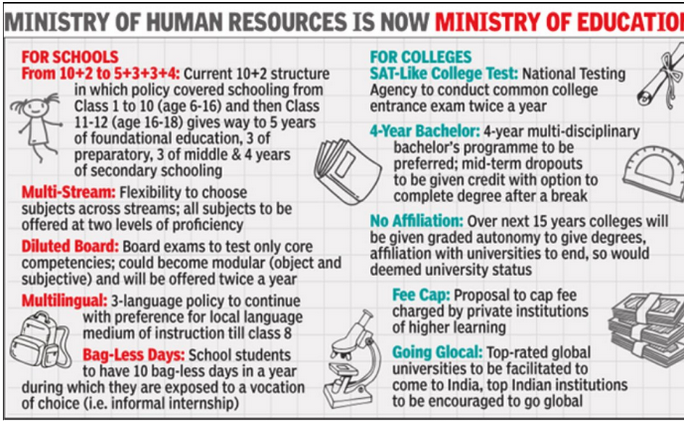News Excerpt:
National Framework of Early Childhood Stimulation framework document says learning begins at birth; staff in 14 lakh anganwadis to be trained and parents encouraged to engage toddlers in activities to reach milestones.
key points about the National Framework of Early Childhood Stimulation 2024
- It lays down month-by-month activities to be conducted by parents, anganwadi staff, and ASHA workers for children from birth to 3 years of age.
- Framework document has been finalized by an internal committee comprising representatives from the Ministry of Women and Child Development, the Ministry of Health and Family Welfare, the Department of School Education and Literacy, the Ministry of Education, the National Council of Educational Research and Training, the Institute of Home Economics, the Delhi University and civil society organizations.
- The Navchetana’, activity-based curriculum follows the National Education Policy 2020's call for a continuum of learning.
- Staff of 14 lakh anganwadis will be trained on this curriculum.
- The curriculum involves talking, playing, moving, listening to music and sounds, and stimulation of all the other senses — particularly sight and touch in order to reach developmental milestones across domains, and develop “early language, and emergent literacy and numeracy”.
- The national framework provides detailed information on the importance of brain development in the first 3 years,
- It provides detailed information and step-by-step instructions for caregivers and frontline workers.
- It includes 36 sets of activities for children from 0 to 36 months,
- Activities range from reaching for objects, imitating sounds, spinning bangles, putting objects in and out of a jar in the first year
- After a year, children can feed themselves, explore the house, help in the kitchen, play with dough, and use mirrors.
- At 18 months, they scribble with crayons.
- At 24 months, they sort and match shoes.
- By age three, they cycle, say their names, and identify colors.
- The framework aims to help identify children with developmental delays so activities can be adapted accordingly.
|
Navchetana:
- Navchetana, the National Framework for Early Childhood Stimulation aims to help children develop holistically, based on the principles of serve and return, caregivers' three acts: love, talk, play, and positive guidance.
- Special focus has been given for the screening, inclusion and referrals of Divyang children.
- The Framework provides a stepping stone for children for their long term development, aiming to ensure that all children start their learning journeys on an equal footing Further it aims to empower Anganwack functionaries, the world's largest women-led childcare workforce, with greater knowledge and capabilities for early childhood stimulation
|
|
National Education Policy 2020
Purpose of National Education Policy (NEP):
- The NEP serves as a comprehensive framework to guide the development of education in the country.
- It provides a vision and philosophy for education and serves as a guiding document for educational reforms.
Key Takeaways of NEP 2020
Early Childhood Care and Education (ECCE):
- Recognizing that nearly 85% of brain development occurs before the age of 6, the NEP places a strong emphasis on early childhood care and education.
- It aims to provide universal access to high-quality ECCE, equipping young children to participate and thrive in the educational ecosystem.
- Schools are adopting a flexible, multifaceted, and play-based approach to learning, ensuring a strong foundation for children.
Higher Education:
The NEP proposes sweeping changes in higher education, including:
- Opening up Indian higher education to foreign universities.
- Dismantling of the UGC and AICTE.
- Introduction of a four-year multidisciplinary undergraduate program with multiple exit options.
- Discontinuation of the M Phil program.

School Education:
The policy focuses on transforming school education with the following changes:
- Overhauling the curriculum to emphasise experiential learning and critical thinking.
- Reducing the syllabus to retain core essentials.
- Introducing a new structure of "5+3+3+4" corresponding to different age groups.
- Bringing early childhood education (pre-school) under the formal schooling system.
- Extending the mid-day meal program to pre-school children.
- Emphasising the use of mother tongue or regional language as the medium of instruction until Class 5.
Institutional Reforms:
The NEP aims to transform institutions of higher education by:
- Phasing out single-stream institutions and encouraging universities and colleges to become multidisciplinary.
Implementation of Reforms:
- The NEP provides a broad direction for reforms, but it is not mandatory to follow. The central government and state governments need to collaborate to implement the proposed changes.
- Subject-wise committees will be set up at both central and state levels to develop detailed implementation plans. Yearly joint reviews will be conducted to assess progress.
Applicability of NEP:
- The NEP is not compulsory for states, as education is a concurrent subject. Private schools are not required to change their medium of instruction.
- Bilingual teaching-learning materials will be encouraged for students with different home language
|

